|
| |
Archives
|
Saturday September 22 2007
|
economy
Here's some cheerful news.
American Economy: R.I.P.
|
The US economy continues its slow death before our eyes, but economists, policymakers, and most of the public are blind to the tottering fabled land of opportunity.
| |
[more]
Body of Missing Blonde White Girl Found! (and in other news….)
|
We are witnessing the foundation of the global economy collapsing in front of our eyes, but you wouldn’t know it from reading the news. Newspapers and television around the world are fixated on the trivial. The BBC cannot resist front-page stories about the death of little Madeleine McCann, and the prospect that her parents may be charged in her murder. This story also features prominently in the U.S., but this morning it has been superseded by the one headline that trumps all others – a missing blonde, white girl’s body has been found!
| |
[more]
Leading lender likens US credit crisis to Great Depression
|
The US financial industry displayed fresh signs of distress from the credit crunch afflicting global money markets yesterday, with one mortgage provider describing lending conditions as the worst since the Great Depression of the 1930s.
| |
[more]
The Coming U.S. Hard Landing
|
The utterly ugly employment figures for August (a fall in jobs for the first time in four years, downward revisions to previous months’ data, a fall in the labor participation rate, and an even weaker employment picture based on the household survey compared to the establishments survey) confirm what few of us have been predicting since the beginning of 2007: the U.S. is headed towards a hard landing.
| |
[more]
U.S. Banks Brace for Storm Surge as Dollar and Credit System Reel
|
By now, you’ve probably seen the photos of the angry customers queued up outside of Northern Rock Bank waiting to withdraw their money. This is the first big run on a British bank in over a century. It’s lost an eighth of its deposits in three days. The pictures are headline news in the U.K. but have been stuck on the back pages of U.S. newspapers. The reason for this is obvious. The same Force 5 economic-hurricane that just touched ground in Great Britain is headed for America and gaining strength on the way.
| |
[more]
book recommendation
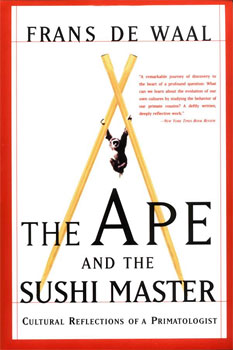
The Ape and the Sushi Master:
Cultural Reflections of a Primatologist
by Frans De Waal
Apes are quite a bit more evolved than they have been given credit and we are perhaps not as evolved as we have credited ourselves.
When apes ape apes
Man is not the only cultured animal to look and learn, as Frans de Waal explains in The Ape and the Sushi Master
|
There is a sad story told about the Californian condor. These magnificent winged scavengers became so reduced in numbers in the 1980s that zoologists decided to round up the last wild animals and establish a breeding colony. Females were carefully isolated and their chicks fed with hand puppets in the colour and shape of adult birds, just the thing to ensure the fledglings would turn into real condors, the scientists reckoned.
They were sadly mistaken. When the young birds were released back to the wild, they promptly abandoned their mountain homes and started hanging around farms and towns. They were simply incapable of scavenging for themselves. 'The normally shy, magnificent foragers had been turned into barnyard chicks perching on rooftops,' says Franz de Waal, a Dutch primatologist now working in Atlanta.
In short, it had proved impossible, despite every effort, not to taint the birds' adolescences and disrupt their ability to learn from their peers. It is a problem that affects not just the captive condor but the hand-reared chimp, the zoo-bred gorilla and the tamed baboon.
In every case, each animal's culture - the milieu that allows them to learn by example from their fellow creatures - is destroyed by the actions and presence of men and women.
Animal culture would therefore seem to be of unassailable importance in understanding the natural world. Yet until recently, most scientists would have flatly rejected its existence. As one put it, culture is 'that which the human species has and other social species lack'. To which de Waal has only one response: a loud raspberry.
| |
[more]
Are You in Anthropodenial?
Frans de Waal portrays altruistic apes and magnanimous monkeys.
|
After finishing Frans de Waal's engaging history of primate studies, ''The Ape and the Sushi Master,'' I wasn't surprised, a day later, to come across a Web site called ''Bush or Chimp?'' The juxtaposition of head shots of the new president alongside chimpanzees, in poses ranging from slack-jawed joviality to goofy hooting, plays off a timeworn joke.
The laughter depends on the underlying assumption that while apes may look like humans, akin even to the most powerful leader in the world, there still must be a quantum leap from them to us. But the laughter grows thinner by the year as one by one the supposed bellwether differences between apes and humans, like toolmaking, fall away. Chimpanzees use leaves as seats, as it turns out; they fashion a kind of footwear to protect themselves from thorns; they ''fish'' for termites with twigs and reeds they strip and cut for the occasion.
But surely culture itself remains impregnable, a fortress where the superiority of human beings, steeped in teaching, learning, language, art and cuisine, still resides. Let Bonzo try to get a table at Elaine's.
Now along comes one of the world's most distinguished primatologists, intent on breaching this last bastion of anthropocentrism. A professor of primate behavior at Emory University and the director of the Living Links Center, de Waal draws on more than 30 years of his own research among captive monkeys, bonobos and other chimpanzees, as well as on studies of wild primates by colleagues around the world, to poke ''a maximum number of holes in the nature/culture divide.''
| |
[more]
CHAPTER ONE: The Ape and the Sushi Master
|
Scientists are supposed to study animals in a totally objective fashion, similar to the way we inspect a rock or measure the circumference of a tree trunk. Emotions are not to interfere with the assessment. The animal-rights movement capitalizes on this perception, depicting scientists as devoid of compassion.
Some scientists have proudly broken with the mold. Roger Fouts, known for his work with language-trained chimpanzees, says in Next of Kin: "I had to break the first commandment of the behavioral sciences: Thou shalt not love thy research subject." Similarly, Jeffrey Masson and Susan McCarthy, in When Elephants Weep, make it seem that very few scientists appreciate the emotional lives of animals.
In reality, the image of the unloving and unfeeling scientist is a caricature, a straw man erected by those wishing to pat themselves on the back for having their hearts in the right place. Unfeeling scientists do exist, but the majority take great pleasure in their animals. If one reads the books of Konrad Lorenz, Robert Yerkes, Bernd Heinrich, Ken Norris, Jane Goodall, Cynthia Moss, Edward Wilson, and so on, it becomes impossible to maintain that animals are invariably studied with a cold, callous eye.
| |
[more]
race
Racism is alive and well in these United States.
The Jena 6 Case is History Written in Lightning
|
The Jena 6 case began last fall when a new black student to the mostly white, rural Louisiana town of Jena sat under the "white tree," so called because it was the place where the white kids at school congregated.
The next day three white boys on the rodeo team hung three nooses from the tree.
The white boys were only given an in-school suspension, their act deemed no more than a "prank."
The day after that several of the school's black high school football stars organized a peaceful silent protest under the tree. The school freaked, called in the police and the next day Reed Walters, the local D.A., addressed the school. There, he is reported to have looked at the black kids in the audience, waved his pen in the air and said, "With a stroke of this pen, I can make your life disappear."
| |
[more]
La. Protests Hark Back to '50s, '60s
|
Drawn by a case tinged with one of the most hated symbols of Old South racism _ a hangman's noose tied in an oak tree _ thousands of protesters rallied Thursday against what they see as a double standard of prosecution for blacks and whites.
The plight of the so-called Jena Six became a flashpoint for one the biggest civil-rights demonstrations in years. Five of the black teens were initially charged with attempted murder in the beating of a white classmate.
| |
[more]
Notes From Jena
|
I am sitting in a coffeeshop in Natchez, MS, trying to decide what to write about today’s demonstration in Jena, LA. The organizer in me wants to lead by reiterating the story that, if you’re reading this, you likely already know- six young men sent to jail on trumped up charges due to the racist actions of a few very stupid, very powerful men… but to me that’s not the most notable story of the day. Those young men certainly deserve justice and thanks in large part to the public attention that’s been focused on the town in the last few months, they may actually get it- but for me this day was the story of one of the largest public declarations of civil rights advocacy in recent memory, one where the whole thing went off without a hitch. No arrests, no hospitalizations, nothing but an entire town full of focused demonstrators who were successful in getting their message out. This day was a model of what social action should always look like, how a large group of individuals can come to the aid of a few in need, and in so doing, change the political dialogue for an entire country. This was the day that restored my faith in mass demonstrations.
| |
[more]
plate photography
Another site with inoformation on whole plate cameras (6 1/2" x 8 1/2"). There are old ones out there but they are often set up for shooting glass plates. This site has a discussion on old style whole plate holders and using film in holders meant for glass plates.
Introduction · to · Traditional · Plate · Camera · Photography
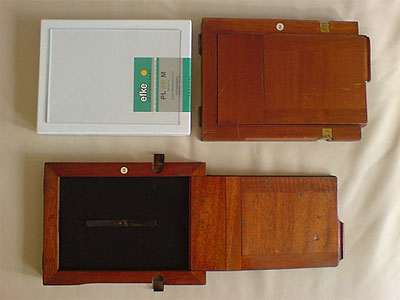
[more]
health care
Expensive and divisive: how America is losing patience with a failing system
|
It's nearing lunchtime and the few people left on the hard chairs in the clinic waiting room are glancing at the television hanging high on the wall. In his examination room, Dr Jamal Gwathney has seen a two-month-old baby, a young woman with a heart pacemaker and chemical burns brought in after a fight with the police, and patients with asthma and diabetes.
But in clinics such as this, just across the Anacostia river from the great white dome of the Capitol, many of the ailments have an underlying cause: none of these people have access to adequate medical care.
"Their healthcare sometimes just takes a back seat to putting food on the table and a roof over their heads," says Dr Gwathney. "They don't come in until their health gets to a critical mass - until they have been having chest pain every day for two or three weeks, or until they start throwing up a little blood with that ulcer that they have and it gets them worried."
On the west side of the dome, in the K Street offices of the doctors profiled in local glossy magazines, medical practices are moving towards concierge-style care: for an annual fee topping $1,000 (£500), a trip to the doctor is akin to a visit to the spa, with appointments on demand, and even the most trivial ailments investigated by costly tests.
Between the two extremes is where America's healthcare system has unravelled. A patchwork of employer benefits and government assistance for the very poor and elderly has produced distinct differences. Those with very good jobs and generous benefits packages enjoy extensive, often almost wasteful, health cover. Meanwhile, tens of millions regularly put their health on hold because they cannot afford basic treatment, prescriptions, or even a visit to the doctor.
| |
[more]
That's America today. If you aren't rich you can just go and fucking die.
book recommendation
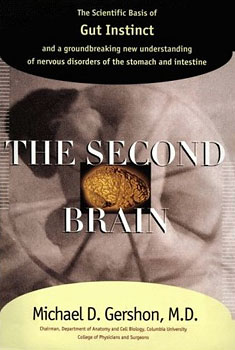
The Second Brain:
The Scientific Basis of Gut Instinct and a Groundbreaking New Understanding of Nervous Disorders of the Stomach and Intestines
by Michael Gershon
Zoe saw Michael Gershon on TV and had to have this book. Zoe has been diagnosed with Irritable Bowel Syndrome (IBS) and the last three years had been very painful until this last February. Things are more under control now. This books gives an understanding of what happens between swallowing and shitting. It's really a pretty amazing story. Gershon was one of the first researchers to study the gut, which is turns out to be a second brain that has a few connections to the brain on top of our shoulders but pretty much runs itself. Another concept that surprised me but shouldn't have is that the gut is a tube running from the mouth to the anal sphincter and what is inside that tube is not inside the body. The contents of the tube aren't inside the body until they traverse the lining of the intestines. This story is how the gut gets the food from one end to the other while extracting what it needs to run the body and getting rid of that which isn't needed. Some of the book gets a bit technical but otherwise it's a fascinating description a pretty important part of our body. One that gives us all trouble sooner or later.
From Amazon:
|
Did you ever tell someone that they think with their stomach? Then you're on the cutting edge of scientific thought, according to researcher Michael D. Gershon. The title of his book The Second Brain refers to the hundred million nerve cells in and around our guts that often act entirely independently of the dictator inside our heads. This isn't so bad--there are some meals we'd rather not have to think about eating, much less digesting. Gershon tells us the stories of his development into a scientist, his determination to promote neurogastroenterology as a legitimate field of research, and the nature of "the brain gone south," all with humor and aplomb.
Though not for the overly squeamish (after all, even if Gershon were to pull his punches, his subject still carries traces of old taboos), The Second Brain is a lively and invigorating read. The illustrations are superb and well labeled; this complements the text, which ranges from clinical to personal, as when the author details the events leading to his mother's tragic death following unnecessary surgery for an ulcer. The interactions between the enteric nervous system and digestion, emotion, and disease are not simple, but Gershon's patient prose explains everything in terms any interested layperson can understand.
As in the best scientific works, The Second Brain informs and inspires, surprising the reader with unexpected complexities and mysteries arising in such a seemingly primitive venue. It makes excellent after-dinner reading.
| |
entropy
Can You Spare a Dime? Why We Could....But Won't
|
One of the most interesting aspects of editing my own older writings on peak oil for my book is how often I find myself change "may" or "could be" or "has been predicted" to "is." That is, it is striking even to me how rapidly we have moved from the realm of prediction to observed phenomena. The habit of thinking in terms of anticipation rather than reality is a hard one to break - after a seeming endless divining of signs and portents and wondering if you are crazy or not, it is strange to suddenly realize, "Oh, we're here in the beginnings of the new world." It shakes me sometimes, and I sometimes wonder if I'm the only one.
That was one of the most striking revelations I had when reading Naomi Klein's wise essay in this month's _Harpers_, "Disaster Capitalism." (The original article, at Harpers, is behind a paywall, and this is somewhat different than the 2005 article of a similar title written in The Nation and available for free - it is really worth reading the article in full, and probably better to read the book from which it is adapted _The Shock Doctrine_) Klein, without a full analysis of the energy implications, has grasped the basic economic reality - that our next "bubble" will be/is the scavenging of wealth from the ordinary poor people (most of us) by the comparatively fortunate (mostly corporations), as we privatize the cleaning up of the messes we've made and pass their costs out upon the rest of us. In fact, one could describe the massive growth in much of the housing industry as an early version of disaster capitalism, offering a fantasy of security to the poor who were bound to lose their security and homes. Bottom feeding is the new black, I guess. As those who can afford it (or who in desperation can secure credit when they can't afford it) pay privately to fix the consequences of the terrible things we've put in motion, the rest of us will be stuck.
Klein quotes, among other figures, the observation that it would cost 1.5 *trillion* dollars in five just to get America's basic engineering infrastructure up to speed - just to keep the bridges from falling down, the sewers from backing up. Since that's a bit less than we intend to spend in Iraq, according to Joseph Steigletz, do any of us really believe that our heavily leveraged economy is going to allow us to spend trillions to fix up the existing infrastructure, much less to engage in the vastly more expensive project of adapting that infrastructure to a low energy, renewable dependent future?
| |
[more]
printer update
He's going to get a printer. No, he's not. Yes, he is. No, he's not. It appears that Don will be getting back his Epson 2200 mid-November and bringing it over to my place so that I can do some printing for him. And some printing for me.

It's smaller than the Epson 3800, which is 17" wide. The Epson 2200 is a 13" wide printer and is a generation behind on inksets. The 2200 uses a 7 ink Ultrachrome inkset and the 3800 uses the 9 ink K3 inkset. The 2200 is still capable of making great prints and I'm looking forward to using it. Really, really!
economy
Fears of dollar collapse as Saudis take fright
|
Saudi Arabia has refused to cut interest rates in lockstep with the US Federal Reserve for the first time, signalling that the oil-rich Gulf kingdom is preparing to break the dollar currency peg in a move that risks setting off a stampede out of the dollar across the Middle East.
"This is a very dangerous situation for the dollar," said Hans Redeker, currency chief at BNP Paribas.
"Saudi Arabia has $800bn (£400bn) in their future generation fund, and the entire region has $3,500bn under management. They face an inflationary threat and do not want to import an interest rate policy set for the recessionary conditions in the United States," he said.
The Saudi central bank said today that it would take "appropriate measures" to halt huge capital inflows into the country, but analysts say this policy is unsustainable and will inevitably lead to the collapse of the dollar peg.
| |
[more]
thanks to Politics in the Zeros
drawing
The Essence of Line
French drawings from Ingres to Degas
|
Welcome to this database of nineteenth-century French drawings. From revealing preparatory sketches to exquisite finished watercolors, more than 900 works by artists such as Eugéne Delacroix, Honoré Daumier, Paul Cézanne, and Edgar Degas illuminate the range of French art over the course of a century of innovation.
| |
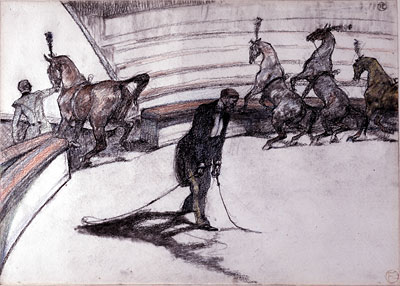
Henri de Toulouse-Lautrec, 1864-1901
At the Circus: Free Horses (Au Cirque: Chevaux en Liberté)
[more]
end of empire
America’s Hegemonic Status Slipping Away
|
For most of the 21st century I have been pointing out that offshoring is not trade, free or otherwise. It is labor arbitrage. By replacing US labor with foreign labor in the production of goods and services for US markets, US firms are destroying the ladders of upward mobility in the US. So far economists have preferred their delusions to the facts.
It is becoming more difficult for economists to clutch to their bosoms the delusion that offshoring is free trade. Ralph Gomory, the distinguished mathematician and co-author with William Baumol, past president of the American Economics Association, of Global Trade and Conflicting National Interests, the most important work in trade theory in 200 years, has entered the public debate.
In an interview with Manufacturing & Technology News (September 17), Gomory confirms that there is no basis in economic theory for claiming that it is good to tear down our own productive capability and to rebuild it in a foreign country. It is not free trade when a company relocates its manufacturing abroad.
Gomory says that economists and policymakers “still are treating companies as if they represent the country, and they do not.” Companies are no longer bound to the interests of their home countries, because the link has been decoupled between the profit motive and a country’s welfare. Economists, Gomory points out, are not acknowledging the implications of this decoupling for economic theory.
A country that offshores its own production is unable to balance its trade. Americans are able to consume more than they produce only because the dollar is the world reserve currency. However, the dollar’s reserve currency status is eroded by the debts associated with continual trade and budget deficits.
The US is on a path to economic Armageddon. Shorn of industry, dependent on offshored manufactured goods and services, and deprived of the dollar as reserve currency, the US will become a third world country. Gomery notes that it would be very difficult—perhaps impossible—for the US to re-acquire the manufacturing capability that it gave away to other countries.
| |
[more]
camera gear
Candid Camera
The cult of Leica.
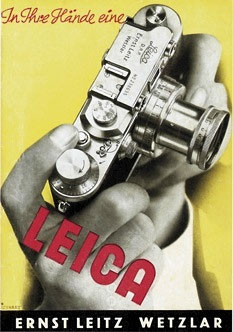
Leica advertising from 1935, when the
camera was widely in use by Europeans+
|
Fifty miles north of Frankfurt lies the small German town of Solms. Turn off the main thoroughfare and you find yourself driving down tranquil suburban streets, with detached houses set back from the road, and, on a warm morning in late August, not a soul in sight. Nobody does bourgeois solidity like the Germans: you can imagine coming here for coffee and cakes with your aunt, but that would be the limit of excitement. By the time you reach Oskar-Barnack-Strasse, the town has almost petered out; just before the railway line, however, there is a clutch of industrial buildings, with a red dot on the sign outside. As far as fanfare is concerned, that’s about it. But here is the place to go, if you want to find the most beautiful mechanical objects in the world.
Many people would disagree. Bugatti fans, for instance, would direct your attention to the Type 57 Atlantic, the only car I know that appears to have been designed by masseuses. Personally, I would consider it a privilege to die at the wheel of a Lamborghini Miura—not difficult, when you’re nudging a hundred and seventy m.p.h. and waving at passersby. But automobiles need gas, whereas the truest mechanisms run on nothing but themselves. What is required is a machine constructed with such skill that it renders every user—from the pro to the banana-fingered fumbler—more skillful as a result. We need it to refine and lubricate, rather than block or coarsen, our means of engagement with the world: we want to look not just at it, however admiringly, but through it. In that case, we need a Leica.
There have been Leica cameras since 1925, when the Leica I was introduced at a trade fair in Leipzig. From then on, as the camera has evolved over eight decades, generations of users have turned to it in their hour of need, or their millisecond of inspiration. Aleksandr Rodchenko, André Kertész, Walker Evans, Henri Cartier-Bresson, Robert Capa, Robert Frank, William Klein, Garry Winogrand, Lee Friedlander, and Sebastião Salgado: these are some of the major-league names that are associated with the Leica brand—or, in the case of Cartier-Bresson, stuck to it with everlasting glue.
Even if you don’t follow photography, your mind’s eye will still be full of Leica photographs. The famous head shot of Che Guevara, reproduced on millions of rebellious T-shirts and student walls: that was taken on a Leica with a portrait lens—a short telephoto of 90 mm.—by Alberto Díaz Gutiérrez, better known as Korda, in 1960. How about the pearl-gray smile-cum-kiss reflected in the wing mirror of a car, taken by Elliott Erwitt in 1955? Leica again, as is the even more celebrated smooch caught in Times Square on V-J Day, 1945—a sailor craned over a nurse, bending her backward, her hand raised against his chest in polite half-protestation. The man behind the camera was Alfred Eisenstaedt, of Life magazine, who recalled:
I was running ahead of him with my Leica, looking back over my shoulder. But none of the pictures that were possible pleased me. Then suddenly, in a flash, I saw something white being grabbed. I turned around and clicked.
| |
[more]
thanks to Leica User Forum
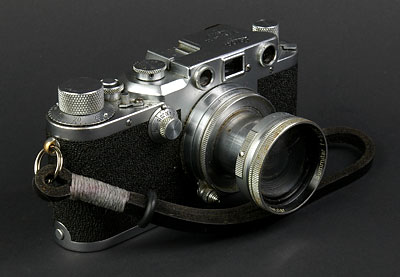
My 1949 Leica IIIc. Smooooooth! It's like taking pictures with jewelry. I'm eternally grateful to my Grandfather Maclaughlin for his good taste in cameras. I still need to get the Summitar lens cleaned.
|
Thursday September 20 2007
|
guns and religion
This is a thought provoking interview. A must read. I've recommended a James Carroll book: House Of War: The Pentagon and the Disastrous Rise of American Power. Carroll also does a regular collumn available at his website.
American Exceptionalism Meets Team Jesus
A Tomdispatch Interview with James Carroll
|
Tomdispatch: I recently heard this joke: How many neocons does it take to screw in a light bulb? The answer: Neocons don't believe in light bulbs, they declare war on evil and set the house on fire.
(Carroll chuckles.)
TD: That's my introduction to a discussion of American fundamentalism. Any comments?
James Carroll: Well, embedded in that joke is a central idea: that what matters is not outcome, but purity of intent. A mark of a fundamentalist mindset is that one's own personal virtue is the ultimate value. The American fundamentalist ethos of the Cold War prepared us to destroy the world. In other words, a world absolutely devastated through nuclear war was acceptable as an outcome because it reflected the virtue of our opposition to the evil of communism. Better dead than red.
TD: A phrase I hadn't thought about in a long time...
Carroll: Better the world destroyed than taken over by communism. It's profoundly nihilistic, which is also one of the marks of the fundamentalist mindset. An irony, of course, is that so much, then and now, is done in the name of realism, but this is such a profoundly unrealistic way of thinking.
| |
[more]
table top
It's been busy and it looks like it will get busier. With paying work, even. One of the things I've been working on is some table top product photography. In between paying work I did this photo of my Pentax Spotmatic F with the 85/1.8. I'm *really* happy the way it came out. Below the Pentax is a picture of my FED 2. That was about 3 years ago when I was first setting up for table top photography. The FED 2 was shot with a single hot light. I did something different with the Pentax shot. I've been using two Vivitar 285HVs, one on each side, but this time I shot through the 43" white Westcott umbrellas placed very close to the camera. The next step is to build a light tent. I have a friend that is sending me some plastic diffusion material he really likes (heavy white plastic used for trash compactor bags) and then I need to attach that to some pvc pipe.
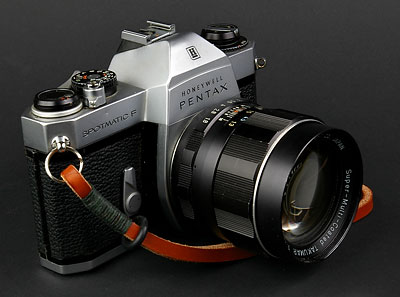
bigger
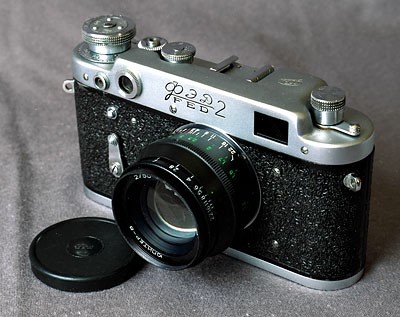
bigger
global climate change
What Global Warming Looks Like
New Report Visualizes Impact of Sea Level Rise on U.S. Coastal Cities

This is Boston under 3 meters of water.
[more]
thanks to Huffington Post
pencil sharpeners
I've started using this pencil sharpener over a year ago. It lives in my pocket, which seems to be a harsh environment. The plastic hinge gave out over 6 months ago and was replaced with gaffer's tape. I replaced the blades a couple of months after that. The top lid is now almost cracked all the way through and it's time for a new one.
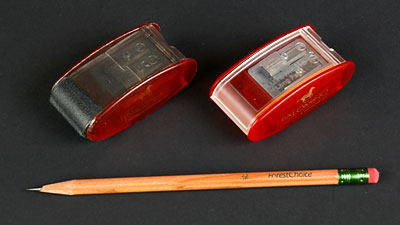
This is a Palomino - KUM Long Point Metal Pencil Sharpener available at Pencil World Creativity Store. It's the best pencil sharpener I've ever owned. I use the Forest Choice pencils also available at the Pencil World Creativity Store. Great pencils
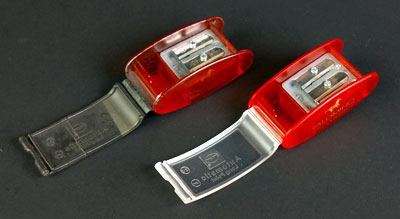
It first sharpens the wood and then you insert it into the second hole to sharpen the lead. You can get replacement blades.
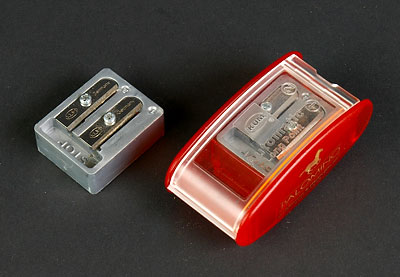
While the outer case is falling apart the sharpening part is just fine so I broke the case off of it. I can use it as a backup when I can't find the new sharpener.
prisons are us
Why Are So Many Americans in Prison?
Race and the transformation of criminal justice
|
The early 1990s were the age of drive-by shootings, drug deals gone bad, crack cocaine, and gangsta rap. Between 1960 and 1990, the annual number of murders in New Haven rose from six to 31, the number of rapes from four to 168, the number of robberies from 16 to 1,784—all this while the city’s population declined by 14 percent. Crime was concentrated in central cities: in 1990, two fifths of Pennsylvania’s violent crimes were committed in Philadelphia, home to one seventh of the state’s population. The subject of crime dominated American domestic-policy debates.
Most observers at the time expected things to get worse. Consulting demographic tables and extrapolating trends, scholars and pundits warned the public to prepare for an onslaught, and for a new kind of criminal—the anomic, vicious, irreligious, amoral juvenile “super-predator.” In 1996, one academic commentator predicted a “bloodbath” of juvenile homicides in 2005.
And so we prepared. Stoked by fear and political opportunism, but also by the need to address a very real social problem, we threw lots of people in jail, and when the old prisons were filled we built new ones.
But the onslaught never came. Crime rates peaked in 1992 and have dropped sharply since. Even as crime rates fell, however, imprisonment rates remained high and continued their upward march. The result, the current American prison system, is a leviathan unmatched in human history.
According to a 2005 report of the International Centre for Prison Studies in London, the United States—with five percent of the world’s population—houses 25 percent of the world’s inmates. Our incarceration rate (714 per 100,000 residents) is almost 40 percent greater than those of our nearest competitors (the Bahamas, Belarus, and Russia). Other industrial democracies, even those with significant crime problems of their own, are much less punitive: our incarceration rate is 6.2 times that of Canada, 7.8 times that of France, and 12.3 times that of Japan. We have a corrections sector that employs more Americans than the combined work forces of General Motors, Ford, and Wal-Mart, the three largest corporate employers in the country, and we are spending some $200 billion annually on law enforcement and corrections at all levels of government, a fourfold increase (in constant dollars) over the past quarter century.
Never before has a supposedly free country denied basic liberty to so many of its citizens. In December 2006, some 2.25 million persons were being held in the nearly 5,000 prisons and jails that are scattered across America’s urban and rural landscapes. One third of inmates in state prisons are violent criminals, convicted of homicide, rape, or robbery. But the other two thirds consist mainly of property and drug offenders. Inmates are disproportionately drawn from the most disadvantaged parts of society. On average, state inmates have fewer than 11 years of schooling. They are also vastly disproportionately black and brown.
| |
[more]
thanks to wood s lot
gear
Last week I finally was able to clear out my little studio space in the basement. It kept filling up with stuff until I hardly had space to put the tripod. Now it's all cleaned up and rearranged. Now I can to some more table top shooting.
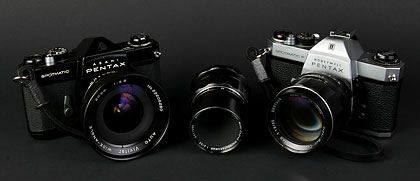
bigger
Shot with 2 Vivitar 285 HVs through umbrellas. I've been shooting the Spotmics more. I had considered getting a Nikon F3. A friend had lent me his and it really is sweet. They can be had for good prices. But in the end I've decided to stick to the Pentax Spotmatics. They are a lot less. Bodies can be had for around $30. Lenses are inexpensive, too. A Pentax Spotmatic body and Pentax Takumar lens were top of the line in the late 1960s and early 1970s. They are wonderful to use. Very high quality. My friend Vern had an older firend of his die recently. His friend was a camera collector and Vern has been helping his widow by going through his cameras and picking out what can be sold. I will be helping him sell the Spotmatics and rangefinders. Two of the lenses in the picture are from that collection. On the Black Spotmatic SP is a Vivitar 20/3.8. Very wide but still rectilinear. Vern has a Nikkor 20mm lens so he is pretty spoiled. He claimed this lens wasn't horrible. It actually seems pretty decent. It has a little fungus so we really can't sell it. They can be had on eBay for under $50. The lens on the right, on the Spotmatic F, is a Super-Multi-Coated Takumar 85/1.8. This lens is highly desirable. Very sharp and fast. Unfortunately it also has a small bloom of fungus. It doesn't really affect the image but makes it unsaleable. Vern will be going down next month and bringing the rest of the gear back. I will list it here before going to eBay. The lens in the middle is my 50/4 Super-Multi-Coated Takumar Macro. The Spotmatics are a joy to use. The Pentaxes, in the 1960s, defined what a SLR was to be. The Spotmatic is the camera everyone copied.
|
|
|
|















